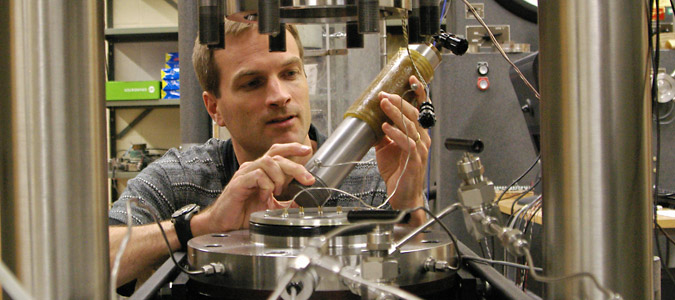Developing tools for underground carbon storage
University of Saskatchewan geological engineering researcher Chris Hawkes is putting the squeeze on rocks in a project that will involve laboratory testing and the development of new, powerful computer simulations to find out how to inject carbon dioxide (CO2) deep underground and make sure it stays there.
By Mark Ferguson "What we have to do is emulate the conditions that exist in Earth's subsurface," Hawkes explains.
"What we have to do is emulate the conditions that exist in Earth's subsurface," Hawkes explains.
The project is supported by a $633,000 grant from Carbon Management Canada, a Network of Centres of Excellence that supports game-changing research to radically reduce carbon emissions from the fossil energy industry.
The innovative multi-institution project is an integral part of finding out whether carbon capture and storage (CCS) is a viable option to help deal with carbon dioxide (CO2) emissions from coal-fired power plants. There are about 50 such plants in Canada, each producing more than a million tonnes of the greenhouse gas per year.
For years, oil companies have injected CO2 into porous oil-bearing rock formations to "push" the oil towards the well heads in a process called enhanced oil recovery (EOR). With CCS, the aim is to use similar injection techniques to store CO2 underground indefinitely, where it won't contribute to global climate change. However, for this process to work, the porous rock needs to lie under a layer of impervious "caprock" that must remain intact.
To help predict performance of these porous rock-caprock formations, Hawkes and the U of S geomechanics group are collaborating with researchers at the University of Waterloo and the University of Calgary, including graduate students funded by the U of C's Institute for Sustainable Energy, Environment and Economy (ISEEE).
"This unconventional approach brings together state-of-the-art tools and methods from geomechanics and reservoir engineering and is expected to yield better, more powerful computer simulations," Hawkes said.
To mimic field conditions, the researchers squeeze rock cores to simulate conditions deep underground, then inject them with pressurized water or CO2 to see how they deform under stress and how fluids flow through them. The cores can also be heated to test how they hold up to temperature change — an important consideration, as sudden temperature changes can cause some rock types to crack.
This information will form the basis for computer simulations to predict how injected CO2 might behave underground. These powerful tools will allow assessment of potential CCS sites, from deep saltwater aquifers to mature oil reservoirs, and point to the most effective injection methods.
"These enhanced tools are badly needed to determine whether underground CO2 storage is a viable and secure option that can be scaled up to play a significant role in managing global emissions," Hawkes said.
While the typical rate of injection in CO2 storage pilot studies is one megatonne (million tonnes) per year or less, it is thought this rate needs to be several times higher. Enhanced simulation tools, such as those developed by this research, will allow engineers to predict and respond to changing conditions at CO2 storage sites where the rate of injection is an expected 10 to 30 megatonnes per year.
In the 2011 round of Carbon Management Canada funding, $10 million is being awarded to Canadian researchers working on 18 projects. Decisions to fund research projects are made after a rigorous international peer-review process.

